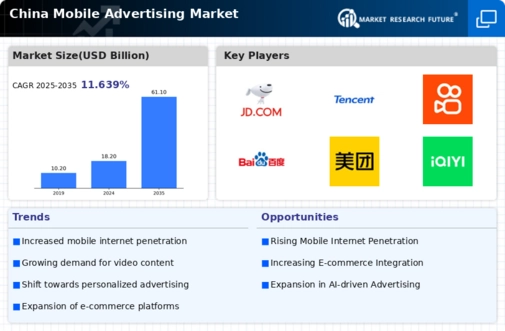Evolving Consumer Behavior
Consumer behavior in China is rapidly evolving, significantly impacting the mobile advertising market. With a growing preference for online shopping and mobile payments, consumers are increasingly engaging with brands through their mobile devices. Data suggests that over 70% of consumers in urban areas utilize mobile apps for shopping, which presents a lucrative opportunity for advertisers. The mobile advertising market is adapting to these changes by developing targeted campaigns that resonate with consumers' preferences. Additionally, the rise of social media platforms has transformed how brands interact with their audience, leading to innovative advertising strategies. This shift in consumer behavior indicates that advertisers must remain agile and responsive to the changing landscape, ensuring that their campaigns are relevant and effective in capturing consumer attention.
Expansion of 5G Technology
The rollout of 5G technology in China is poised to have a transformative impact on the mobile advertising market. With significantly faster data speeds and lower latency, 5G enables richer and more interactive advertising experiences. As of November 2025, it is projected that over 500 million users will have access to 5G networks, creating new opportunities for advertisers to engage consumers through high-quality video content and augmented reality experiences. The mobile advertising market stands to benefit from this technological advancement, as brands can create more immersive and engaging campaigns that capture consumer attention. This expansion of 5G technology may lead to a shift in advertising strategies, with a focus on innovative formats that leverage the capabilities of next-generation networks. As such, advertisers must adapt to this evolving landscape to maximize their reach and effectiveness.
Rising Smartphone Penetration
The mobile advertising market in China is experiencing a notable surge due to the increasing penetration of smartphones. As of 2025, approximately 1.2 billion smartphones are in use across the country, representing a penetration rate of around 85%. This widespread adoption facilitates greater access to mobile internet, enabling advertisers to reach a larger audience. The mobile advertising market benefits from this trend as more consumers engage with mobile applications and websites. Consequently, advertisers are allocating more resources to mobile platforms, anticipating higher returns on investment. The shift towards mobile-first strategies is likely to continue, as brands recognize the importance of connecting with consumers through their preferred devices. This driver indicates a robust growth trajectory for the mobile advertising market, as businesses adapt to the evolving digital landscape.
Regulatory Changes and Compliance
The mobile advertising market in China is increasingly influenced by regulatory changes and compliance requirements. Recent government initiatives aimed at enhancing consumer privacy and data protection are reshaping how advertisers approach their campaigns. As of 2025, new regulations mandate stricter consent protocols for data collection, which could impact targeting strategies within the mobile advertising market. Advertisers must navigate these complexities to ensure compliance while still delivering effective campaigns. This evolving regulatory landscape may also drive innovation, as businesses seek to develop transparent and ethical advertising practices. The emphasis on compliance suggests that companies will need to invest in robust data management systems and strategies to maintain consumer trust and adhere to legal requirements. Consequently, this driver highlights the importance of adaptability in the mobile advertising market as regulations continue to evolve.
Integration of AI and Machine Learning
The integration of artificial intelligence (AI) and machine learning technologies is revolutionizing the mobile advertising market in China. These technologies enable advertisers to analyze vast amounts of data, allowing for more precise targeting and personalization of ads. As of 2025, it is estimated that AI-driven advertising solutions account for approximately 30% of the mobile advertising market. This trend suggests that advertisers are increasingly leveraging data analytics to optimize their campaigns, resulting in improved engagement rates and higher conversion rates. Furthermore, AI can enhance user experience by delivering relevant content to consumers, thereby increasing the likelihood of interaction. The ongoing advancements in AI and machine learning are likely to further shape the mobile advertising landscape, making it essential for businesses to adopt these technologies to remain competitive.





















Leave a Comment